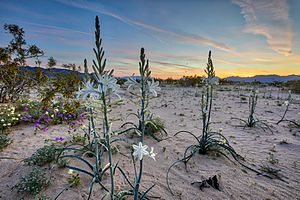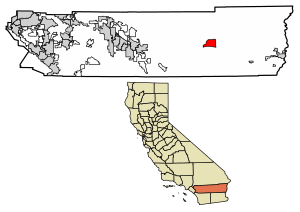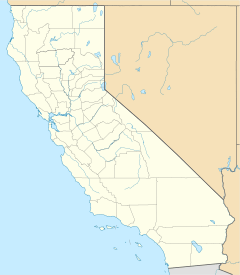Desert Center, California facts for kids
Quick facts for kids
Desert Center
|
|
|---|---|

Desert Center's Desert Lily Preserve
|
|

Location of Desert Center in Riverside County, California
|
|
| Country | United States |
| State | California |
| County | Riverside |
| Area | |
| • Total | 30.43 sq mi (78.80 km2) |
| • Land | 30.43 sq mi (78.80 km2) |
| • Water | 0.00 sq mi (0.00 km2) 0% |
| Elevation | 656 ft (200 m) |
| Population
(2020)
|
|
| • Total | 256 |
| • Density | 8.41/sq mi (3.25/km2) |
| Time zone | UTC−8 (Pacific (PST)) |
| • Summer (DST) | UTC−7 (PDT) |
| ZIP Code |
92239
|
| Area code(s) | 442 and 760 |
| FIPS code | 06-18982 |
| GNIS feature ID | 2582993 |
Desert Center is a small community in the Colorado Desert in Riverside County, California. It is located in southern California. You can find it between the cities of Indio and Blythe. It sits where Interstate 10 and State Route 177 meet. This spot is about halfway between Phoenix and Los Angeles.
The area's ZIP Code is 92239. Its telephone area codes 442 and 760 are also used here. Desert Center is about 656 feet (200 m) above sea level. In 2020, about 256 people lived there.
Contents
History of Desert Center
How Desert Center Began
Desert Center was started in 1921 by Stephen A. Ragsdale and his wife, Lydia. People often called him "Desert Steve." Steve was a traveling preacher and cotton farmer from Arkansas.
In 1915, his car broke down near a place called Gruendyke's Well. A prospector named Bill Gruendyke helped him. When Steve returned, he bought the spot from Gruendyke. He and his family built a small shack and a garage there. They even used a Model T truck as a tow car. Lydia sold food and drinks to travelers.
Steve named his new outpost "Desert Center." Even though it was 50 miles (80 km) from other towns, the Ragsdales did well. In 1921, a new, paved highway, U.S. Route 60, was planned to run through Desert Center. This new road was much faster.
Steve moved his business to the new highway. He built a concrete café, a gas station, and a big garage. He also built a market, a post office, and cabins for travelers. There was even a large swimming pool to help people cool off from the desert heat.
Steve Ragsdale was known for his funny advertisements. He would say things like "U Need Us – We Need U" and "Our Main Street is 100-miles long!" He even offered "Free Room and Board Every Day The Sun Doesn't Shine In Desert Center."
When Steve needed a teacher for the local children, the county said there weren't enough students. So, Steve quickly built a schoolhouse. He then advertised for a mechanic with a big family. This helped him get enough students for the county to send a teacher.
Steve was friends with many famous "desert people." These included Randall Henderson, who started Desert Magazine, and biologist Edmund C. Jaeger. Steve's sons, Stanley, Thurman, and Herbert, later took over the town. Stanley eventually bought Desert Center from his father.
General Patton's Training Center
By 1942, Desert Center had very few people living there. But then, the U.S. Army, led by Maj. General George S. Patton, set up a huge training area nearby. This was called the California-Arizona Maneuver Area. It included the Desert Center Army Air Field and Camp Desert Center.
The training area covered 18,000 square miles (47,000 km2). Its goal was to prepare soldiers for fighting in the deserts of North Africa. They were training to face German forces led by Field Marshal Erwin Rommel. This large operation ended in 1944 after the Allies won in North Africa. Today, a museum honoring Patton is in Chiriaco Summit.
After the army left, Desert Center became quiet again. The old highways were replaced by Interstate 10, but the town stayed mostly the same.
Eagle Mountain Mine and Prison
About 13 miles (21 km) north of Desert Center is the site of the Kaiser Steel Eagle Mountain Mine. This was one of the biggest open-pit iron mines in the world when it opened. Geologists working for Henry J. Kaiser found the rich iron ore in the early 1930s.
The Eagle Mountain Mine operated from World War II until Kaiser closed it in 1982. The nearby town of Eagle Mountain also closed then.
The mine has been used as a filming location for movies and TV shows. Parts of Terminator 2: Judgment Day were filmed there.
A private prison once operated here, using buildings leased from Kaiser Steel. This prison closed on December 31, 2003.
There were also plans to build a very large waste management landfill at the mine site. However, environmental groups took legal action. They wanted to protect the Colorado Desert and its groundwater. These actions stopped the landfill project.
Desert Center Today
Today, Desert Center is a very small community. The United States Post Office is the only business still open. The closest gas and fast food are over 19 miles away in Chiriaco Summit.
Desert Center has farms and two mobile home parks. Many "snowbirds" (people who travel south for winter) stay here. The Lake Tamarisk community is also nearby. It has a golf course and was built by the Kaiser Steel Corporation for mine managers.
The Desert Center Airport ((FAA LID: L64)) has a 4,200-foot (1,300 m) runway. It stopped being a public airport in 1992. Now, it is privately owned. Since 2010, it has been home to the Chuckwalla Valley Raceway. This is a professional motorsports track that clubs and individuals can rent.
In the 1980s, Desert Center saw some growth because of jojoba plants. The area's salty water, sandy soil, and dry weather are perfect for growing this tough desert plant. Its oil is mainly used in beauty products.
In the early 1990s, Stanley Ragsdale planted hundreds of palm trees in unusual patterns along Interstate 10. He said he always wanted a "tree-ring circus." After he passed away in 1999, many of these trees died because they were not cared for.
As of May 2021, a large part of the town was being sold to a resident from Riverside.
The area around Desert Center is now a popular spot for solar energy production. The Desert Sunlight Solar Farm is located nearby.
Local Services
The community is served by State Route 177 and Interstate 10. Most phone numbers in Desert Center and Lake Tamarisk use the (760) 227-xxxx exchange from Verizon Communications. Other phone companies also serve the area. A Caltrans maintenance station was located here in 2000.
Children in Desert Center attend schools in the Desert Center Unified School District. Elementary and middle school students go to Eagle Mountain School in Eagle Mountain, California. High school students take a bus daily to Blythe, California.
The Palo Verde Valley Transit Agency offers transportation services. These help local residents travel to Indio and Blythe.
Lake Tamarisk Community
Lake Tamarisk is a community located about one and three-quarter miles north of Interstate 10. You can find it off Kaiser Road at 33°44′20″N 115°23′20″W / 33.73889°N 115.38889°W. The community has a golf course where it is not expensive to play.
Both the Lake Tamarisk Library and Riverside County Fire Department Station 49 are located in Lake Tamarisk.
Geography of Desert Center
According to the United States Census Bureau, Desert Center covers an area of 30.4 square miles (79 km2). All of this area is land.
Near Desert Center, you can find the Chuckwalla Mountains, Corn Springs, Eagle Mountain (the old Kaiser Steel iron mine), and Chiriaco Summit with its museum.
Climate in Desert Center
Desert Center has a hot desert climate. This means it is very hot and dry. The hottest temperature ever recorded in Desert Center was 121 °F (49.4 °C) on July 9, 2024. The coldest temperature was 14 °F (−10.0 °C) on January 7, 1950.
| Climate data for Hayfield Pumping Plant, California, 1991–2020 normals, extremes 1933–present | |||||||||||||
|---|---|---|---|---|---|---|---|---|---|---|---|---|---|
| Month | Jan | Feb | Mar | Apr | May | Jun | Jul | Aug | Sep | Oct | Nov | Dec | Year |
| Record high °F (°C) | 86 (30) |
91 (33) |
99 (37) |
105 (41) |
114 (46) |
120 (49) |
121 (49) |
118 (48) |
120 (49) |
112 (44) |
94 (34) |
86 (30) |
121 (49) |
| Mean maximum °F (°C) | 77.5 (25.3) |
81.4 (27.4) |
89.5 (31.9) |
98.3 (36.8) |
103.3 (39.6) |
111.0 (43.9) |
114.1 (45.6) |
113.2 (45.1) |
108.9 (42.7) |
100.2 (37.9) |
87.9 (31.1) |
77.6 (25.3) |
115.7 (46.5) |
| Mean daily maximum °F (°C) | 67.1 (19.5) |
70.3 (21.3) |
76.7 (24.8) |
83.3 (28.5) |
91.5 (33.1) |
100.9 (38.3) |
105.5 (40.8) |
105.1 (40.6) |
99.7 (37.6) |
88.4 (31.3) |
75.9 (24.4) |
66.3 (19.1) |
85.9 (29.9) |
| Daily mean °F (°C) | 53.3 (11.8) |
55.8 (13.2) |
61.5 (16.4) |
67.3 (19.6) |
75.6 (24.2) |
84.1 (28.9) |
90.5 (32.5) |
90.4 (32.4) |
83.7 (28.7) |
71.9 (22.2) |
60.3 (15.7) |
52.4 (11.3) |
70.6 (21.4) |
| Mean daily minimum °F (°C) | 39.4 (4.1) |
41.4 (5.2) |
46.3 (7.9) |
51.3 (10.7) |
59.7 (15.4) |
67.3 (19.6) |
75.5 (24.2) |
75.7 (24.3) |
67.6 (19.8) |
55.5 (13.1) |
44.7 (7.1) |
38.6 (3.7) |
55.3 (12.9) |
| Mean minimum °F (°C) | 27.8 (−2.3) |
30.3 (−0.9) |
34.7 (1.5) |
40.4 (4.7) |
48.4 (9.1) |
56.4 (13.6) |
65.4 (18.6) |
64.3 (17.9) |
56.3 (13.5) |
42.3 (5.7) |
32.3 (0.2) |
27.5 (−2.5) |
24.5 (−4.2) |
| Record low °F (°C) | 14 (−10) |
21 (−6) |
18 (−8) |
30 (−1) |
39 (4) |
44 (7) |
56 (13) |
53 (12) |
46 (8) |
29 (−2) |
22 (−6) |
15 (−9) |
14 (−10) |
| Average precipitation inches (mm) | 0.99 (25) |
0.75 (19) |
0.46 (12) |
0.14 (3.6) |
0.10 (2.5) |
0.00 (0.00) |
0.21 (5.3) |
0.37 (9.4) |
0.50 (13) |
0.25 (6.4) |
0.18 (4.6) |
0.66 (17) |
4.61 (117.8) |
| Average precipitation days (≥ 0.01 in) | 3.4 | 3.0 | 2.2 | 1.2 | 0.5 | 0.0 | 1.0 | 1.5 | 1.2 | 1.0 | 0.8 | 2.6 | 18.4 |
| Source 1: NOAA | |||||||||||||
| Source 2: National Weather Service | |||||||||||||
Population of Desert Center
| Historical population | |||
|---|---|---|---|
| Census | Pop. | %± | |
| 2020 | 256 | — | |
| U.S. Decennial Census | |||
In 2010, about 204 people lived in Desert Center. This meant there were about 6.7 people for every square mile. Most people (80.4%) were White. About 18.6% of the people were Hispanic or Latino.
Most people lived in homes, with only a few in group housing. The average home had about 2.39 people. About 20% of the population was under 18 years old. The median age was 47.5 years. For every 100 females, there were about 106 males.
Most homes (72%) were owned by the people living in them. The rest were rented. In 2010, the average household income was $27,031. About 28.8% of the people lived below the poverty line.
Images for kids
See also
 In Spanish: Desert Center para niños
In Spanish: Desert Center para niños




